This post is sponsored by QV.
If you have dry skin, ceramides are an ingredient that deserve more of your attention. Here’s what they are, what they’re good for, and an overview of the QV Intensive with Ceramides range.
What are ceramides?
Ceramides are oily substances that are naturally found in the top layer of your skin, the stratum corneum. They’re one of the main intercellular lipids (along with cholesterol and free fatty acids) that sit in between dead skin cells in the stratum corneum, sticking them together and forming an effective barrier.

This barrier is important for protecting the living layers of your skin against irritants and microbes, as well as slowing down how quickly water evaporates.
In the lipid “mortar” of the stratum corneum, there’s around 40-40-50% ceramides, 25% cholesterol and 10-20% free fatty acids. A lack of ceramides or changes in the types of ceramides has been associated with some forms of dry skin. If this is the case, the stratum corneum is prone to losing water too quickly, resulting in dehydrated skin. This dryness can also lead to itchy skin.
Using ceramide-containing products can help support a healthy skin barrier.
QV Intensive with Ceramides range
There are three products in the QV Intensive with Ceramides range, formulated for people with very dry and itchy skin: the Light Moisturising Cream, Hydrating Body Wash and Sting-Free Ointment.
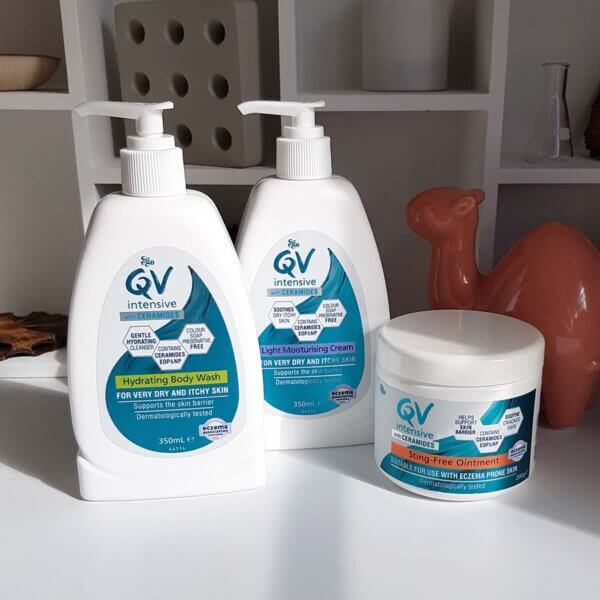
There are a lot of different ceramides in skin – a ceramide consists of a sphingosine base and a fatty acid, so there are quite a few combinations possible! The products in the QV Intensive with Ceramides range contain ceramide EOP (ceramide 1) and ceramide NP (ceramide 3):

All of the products are dermatologically tested, suitable for use on sensitive skin, vegan-friendly, budget-friendly and fragrance-free.
QV Intensive with Ceramides Light Moisturising Cream
QV Intensive with Ceramides Light Moisturising Cream ($26.99 for 350 mL) is a non-greasy moisturiser that absorbs quickly. It’s based on lots of well-researched, bland moisturising ingredients including the hydrating humectants glycerin and sodium PCA, as well as occlusive petrolatum, mineral oil (paraffinum liquidum) and dimethicone. These synthetic ingredients aren’t favoured by people who prefer natural cosmetics, but dermatologists usually recommend these ingredients since they’re so gentle.
Related post: Video: Are Natural Beauty Products Better?
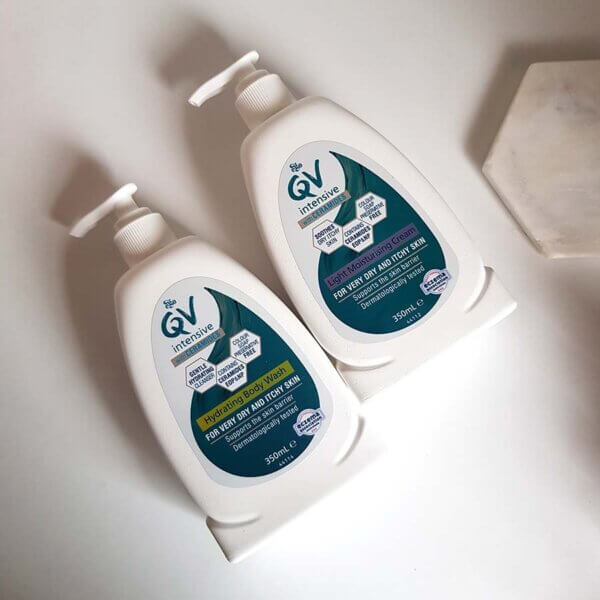
The cream also contains niacinamide (vitamin B3), a do-everything skincare ingredient that helps skin maintain its normal barrier function. It’s also been shown to help stimulate the production of ceramides in the skin, and helps to improve the appearance of skin tone and texture. There’s also lactic acid, which has also been shown to help stimulate the production of ceramides in the skin. Safflower oil, a fantastic emollient plant oil for skin, is also included.

I really like how effective this cream is at moisturising my skin in cold weather, despite not feeling heavy. After showering in winter, my skin tends to try out and get itchy, but with this cream that doesn’t happen. This works as well as a heavy, thick cream, but it’s much faster to rub in, plus the pump top bottle is very convenient. In a clinical study it was found to be more effective at hydrating skin for 24 hours after application than other moisturisers.
Ingredients: Aqua (Water), Glycerin, Petrolatum, Niacinamide, Paraffinum Liquidum, Dimethicone, Cetearyl Alcohol, Lactic Acid, Glyceryl Stearate SE, Ceteareth-20, Sodium PCA, Stearic Acid, Caprylyl Glycol, 1,2-Hexanediol, Laureth-3, Xanthan Gum, Sodium Hydroxide, Ceramide NP, Cholesterol, Carthamus Tinctorius (Safflower) Seed Oil, Ceramide EOP.
QV Intensive with Ceramides Hydrating Body Wash ($23.49 for 350 mL) is a gentle cleanser that is designed to help hydrate the skin while cleansing. It’s pH-balanced with a rich cream texture. Like the Light Moisturising Cream, there are lots of bland and effective moisturising ingredients (petrolatum, glycerin, sodium PCA) as well as niacinamide, lactic acid and safflower oil. It uses gentle surfactants that won’t strip the skin or dry it out. It also comes in a convenient pump top, and is great for avoiding post-shower dry, itchy skin.
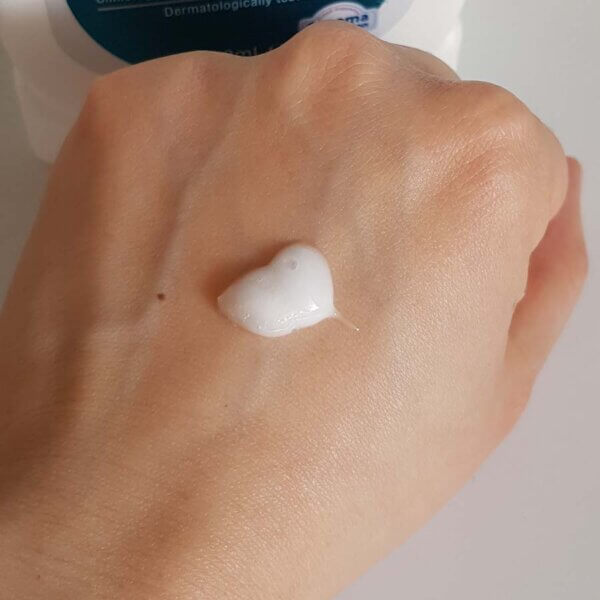
Ingredients: Aqua (Water), Petrolatum, Sodium Lauroyl Sarcosinate, Glycerin, Niacinamide, Lauryl Betaine, Lactic Acid, Sodium Cocoyl Isethionate, Sodium PCA, Xanthan Gum, 1,2-Hexanediol, Caprylyl Glycol, Sodium Polyacrylate, Ceramide NP, Cholesterol, Carthamus Tinctorius (Safflower) Seed Oil, Ceramide EOP.
QV Intensive with Ceramides Sting-Free Ointment ($12.95 for 100 g or $21.95 for 200 g) is a water-free ointment that’s designed to be used on dry, cracked skin. It contains the same ceramides, in a thick moisturising base, and acts as a barrier that keeps your irritated skin hydrated. It’s a lot like petroleum jelly, but with the added benefit of ceramides.

I prefer the tub to the tube, since the product’s very thick – in cold weather it can be a bit difficult to squeeze out from the tube, although it’s not a dealbreaker since you never need to use very much and a little goes a long way. I’ve found it really fantastic for soothing and protecting dry, cracked cuticles and heels.

Ingredients: Paraffinium Liquidum, Petrolatum, Isopropyl Myristate, Polyethylene, Aluminium Starch Octenylsuccinate, Cetearyl Alcohol, Ozokerite, Silica, Dimethicone, Ceramide NP, Cholesterol, Carthamus Tinctorius (Safflower) Seed Oil, Ceramide EOP.
Have you used skincare products with ceramides before? What did you think?
References
Del Rosso JQ, Levin J. The clinical relevance of maintaining the functional integrity of the stratum corneum in both healthy and disease-affected skin. J Clin Aesthet Dermatol. 2011;4(9):22-42.
Imokawa G, Akasaki S, Hattori M, Yoshizuka N. Selective recovery of deranged water-holding properties by stratum corneum lipids. J Invest Dermatol. 1986;87(6):758-761. doi:10.1111/1523-1747.ep12456950
Lin TK, Zhong L, Santiago JL. Anti-Inflammatory and Skin Barrier Repair Effects of Topical Application of Some Plant Oils. Int J Mol Sci. 2017;19(1):70. Published 2017 Dec 27. doi:10.3390/ijms19010070
Rawlings AV, Davies A, Carlomusto M, et al. Effect of lactic acid isomers on keratinocyte ceramide synthesis, stratum corneum lipid levels and stratum corneum barrier function. Arch Dermatol Res. 1996;288(7):383-390. doi:10.1007/BF02507107
Spada F, Barnes TM, Greive KA. Skin hydration is significantly increased by a cream formulated to mimic the skin’s own natural moisturizing systems. Clin Cosmet Investig Dermatol. 2018;11:491-497
DOI: 10.2147/CCID.S177697
This post is sponsored by QV; however, the content is all based on my independent research and my honest experience. For more information, see Disclosure Policy.


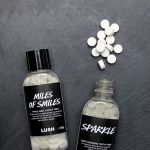

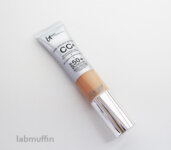
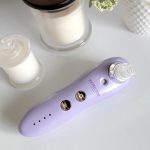
These product look awesome, QV is not available here in France but I use Bioderma Atoderm Intensive Balm which seems similar and comes with a pump 😀
The mineral oil contained in these moisturisers already helps to relieve dry skin, but do we actually know how much ceramide must be present in a formula to benefit from its effects?
How do you feel the QV moisturizer compares to others that have similar ingredients? Like the cereve nighttime moisturizer?
Thanks Michelle! How does it compare to Cerave? Has anyone tried both?
QV is life!
I’m currently trying Dr Sam Bunting’s range, I’m fairly sure the moisturiser has ceramics. I’m really enjoying it 🙂
I started using CeraVe Daily Moisturising Lotion a few months ago for my toddler who suffers from some eczema and dry skin. It’s the only thing that has kept her rashes and dry patches under control this winter. I’ve also started using it, as I noticed my hands had never been so smooth after using it on her this whole time. I was either going to get CeraVe or these QV products you talked about. Good to know these QV ones have your stamp of approval too.
If QV cream is available to you and you haven’t given it a shot please do try it! i found cerave to not be as hydrating as the regular qv cream when using on my body. For my face I prefer Cerave but QV was so much more easier to use on the body – glides better and felt more hydrating.
Hi! I’m a new fan of your blog, and this is my first post. Because I’m also a huge fan of ceramides! My immune system basically hates me and has always attacked my skin. But for two years it went crazy and my skin was flaking off in literal piles. My doctor never came up with a diagnosis but tried all sorts of treatments from immune suppresant drugs to experimental UV treatments. Meanwhile, I was using CeraVe creams and lotions to hold the “mortar” the best it could. I eventually found out the problem was with the municipal water where I lived. After moving, and continuing using CeraVe, my skin recovered and it’s actually better than before the flaking, when I wasn’t using their products. I also use their moisturizing bar soap and facial cleanser. It’s not luxurious or anything but it works. I’ll take clinical over a beauty brand. QV sounds like something I might want to try, too.
CeraVe products usually have three types of ceramides, sodium hyaluronate, tocopherol, and other good stuff. I read a lot of people who haven’t tried the cleanser saying it was useless to put all that in acleanser when it’s just going to get washed off. But it’s not true – the second it touches my skin, my skin gets visibly nice and plushy, and stays that way after I’ve washed it off.
My favorite ceramide product for lips is Holika Holika Good Cera Lip Oil Balm. Feels like a petroleum balm but your skin can still breathe. And after it wears away, your lips still feel moisturized, like you don’t have to keep reapplying.
So my only issue now is my scalp.. Shampoos that address dry scalp tend to be horrible for hair, and vice versa. So I want to find something like Kerastase scalp essence but not as expensive. 🙂
Anyway, thanks for sharing your scientific expertise! This is definitely one of my favorite beauty blogs and resources.
I started using CeraVe Daily Moisturising Lotion a few months ago for my toddler who suffers from some eczema and dry skin. It’s the only thing that has kept her rashes and dry patches under control this winter. I’ve also started using it, as I noticed my hands had never been so smooth after using it on her this whole time. I was either going to get CeraVe or these QV products you talked about. Good to know these QV ones have your stamp of approval too.
Does a chemical exfoliant, e.g. glycolic acid, reduce the benefit of a ceramide topical product?
I found that the light moisturising cream didn’t absorb well into the face, but then again I’m norm-oily combo. The light moisturising cream was phenomenal as a 2nd cleanse in the shower though! And I do love the ointment.
I’ve tried several products with ceramides and either the vehicle or the active ingredients seem to bother my skin quite a bit, causing redness and itchy irritation. Currently working on a monster spreadsheet to try and identify the common ingredients, and from there the possible irritating suspects, it’s a beast of a project!
Do you by chance have any information on ceramide allergies, or is that not a thing?
I do use ceramides as part of my skincare, although I haven´t really made up my mind how much their contribution to my overall skin health actually is – hard to judge when using them in a well-balanced formula. But they are an ingredient that I enjoy seeing in my products.
The QV moisturiser reminded me of a question I’ve always wondered. If you have a product which combines humectants and occlusives, do the occlusives prevent the absorption of moisture (or any other ingredient in the product that you want absorbed)do any degree?
To create a simple but hopefully illustrative example; would a mix of glycerin and petrolatum be as hydrating as putting the glycerin on first and then adding the vaseline on top? and if not, would it be only slightly inhibited, or significantly? how much would this change if you adjusted the ratio of glycerin to petrolatum in either direction?
It can’t be impossible, since moist moisturisers contain both humectants *and* occlusives, but I am curious if it does have an effect.
Thank you Michelle, as a fellow Aussie skincare nerd I appreciate you trawling through peer-reviewed papers so I don’t have to *so* very much ^^ Thank you for your service!
It’s really hard for occlusives to block anything for any extended amount of time – you don’t have to worry about it if they’re combined in a product. But if you have a TON of petrolatum maybe it would, like if you had a product that was just 85% petrolatum + 15% glycerin (but that doesn’t exist AFAIK because that would be an awful product).